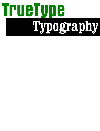
For the best TrueType Logos
Can't anyone make TrueType logos?
Companies offering to digitize your company logo as a TrueType font are a dime a dozen. The benefits of logo-fonts - in marketingspeak - are probably familiar but they're worth repeating:
So, whoever makes your TrueType logo-fonts, there are a number of benefits right away. Are we any different?
Stage 1: The Outline
If your logo's master artwork exists on paper, it will first be scanned - as a bitmap - into a computer. Then it is traced to obtain an outline form. We trace logos (and fonts) manually, since automatically traced outlines are less efficient in storage & performance, less hintable and show irregularities at small and large sizes.
If you've already got your logo in a digital outline format (e.g. Illustrator, Corel, FreeHand), then converting it into TrueType's curve format is a straightforward process - most off-the-shelf font tools do a reasonable job.
Stage 2: The Hinting
This is where most of the TrueType logo providers fall down. If asked, they might mumble something about "auto-hinting", or the logos being "fully hinted". Now the auto-hinting algorithms (in Fontographer, FontLab, etc.) can indeed improve on an unhinted text font - when the type design is fairly simple and consistent. With logos however, there's only a single character to analyse, rendering auto-hinting next to useless. The program (Fontographer, etc.) might not report its inability to auto-hint, but that doesn't mean it's improved the logo.
By contrast, we offer full manual hinting. With each logo we hint, we will discuss with you the features we intend to control with hinting, and agree which features should be preserved to the smallest possible size, and which can be discarded at the smallest sizes to make that possible.
Q: "I've already had my logo made into a TrueType font, but it still looks poor on screen..."
Our expert hinting can drastically improve a logo at screen resolutions. As long as your logo's outlines have been digitized well, we can add our hinting to existing logos. The low-resolution quality will be enhanced without affecting the quality at high resolutions.
Q: "Our logo has a number of colours. How can we turn this into a font, which surely contains no colour data?"
A logo-font itself cannot contain colour data. But many logos can be separated into their constituent colours. We divide colour logos up in this way - placing each coloured component into a different character cell (e.g. A for the black parts, B for the green, C for the blue). To assign colour to each part, one uses the application itself. So, to get the logo in colour:
- Type, say, "ABC" in a readable text font;
- Set each letter to the correct colour, using the application's colour commands;
- Select the "ABC" text and switch fonts to the logo-font.
Q: "What do I need to supply as a starting point for a high quality TrueType version of my logo?"
We can accept:
- Artwork on paper.
- Bitmap files (TIFF, BMP, GIF) at high resolution.
- Outline files (Illustrator, Corel, FreeHand).
- TrueType and Type 1 logo-fonts previously made by other companies.
For any enquiries about our TrueType logo outline & hinting services, please get in touch via the Contact page.
TYPE*chimérique | TrueType Typography | TYPE*links